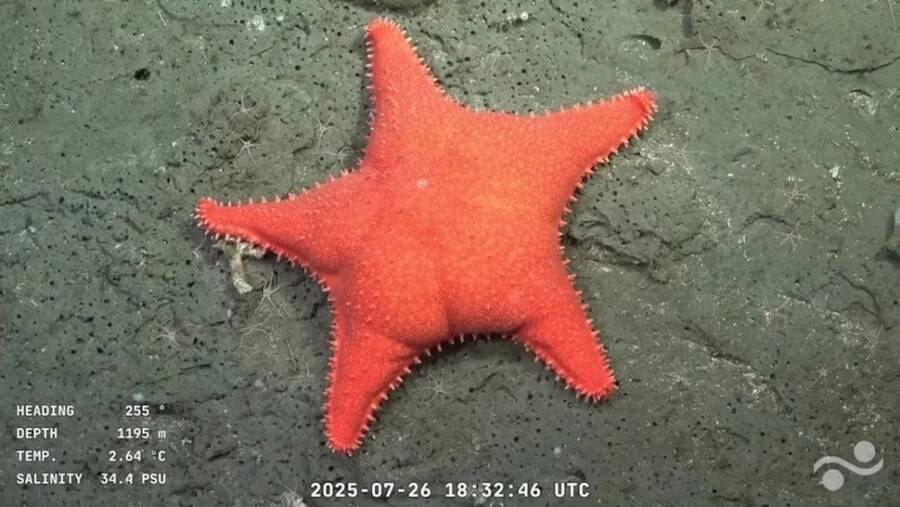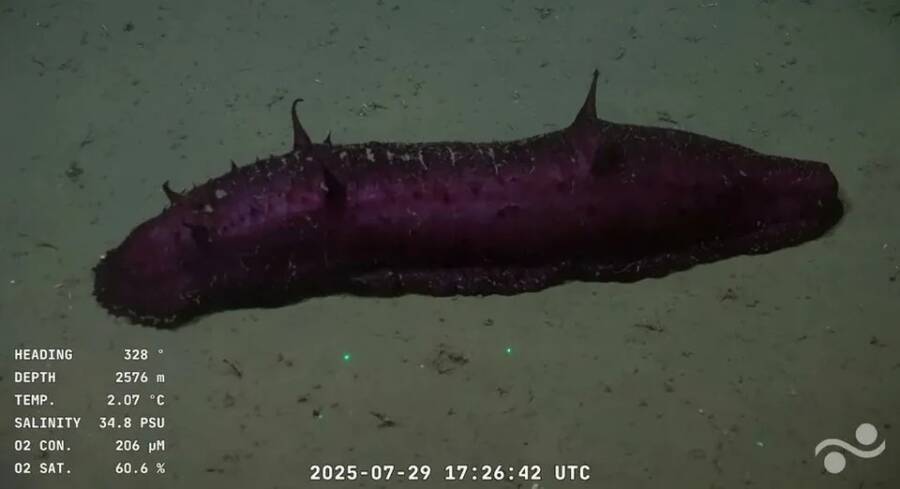Believed to belong to the genus Hippasteria, this pinkish-orange creature was found clinging to a rock at a depth of 3,280 feet — and despite its nickname, the cleft area between two of the creature's legs is not its posterior.

Schmidt Ocean Institute/YouTubeThe “big-butt starfish” was spotted during an underwater expedition at Argentina’s Mar del Plata submarine canyon.
Scientists recently documented dozens of unique ocean species, some of them previously unknown, during an underwater expedition off the coast of Argentina. Perhaps most notably among these discoveries, scientists spotted a starfish with the appearance of a big butt and an uncanny likeness to Patrick Star from the animated show SpongeBob SquarePants.
The starfish has been dubbed the “big-butt starfish,” and scientists have a few theories to explain its striking anatomy. It was found in the Mar del Plata submarine canyon during an international expedition using a remotely-operated vehicle.
The expedition aimed to explore seldom-seen corners of this especially biodiverse region. And the creatures recorded during this mission certainly did not disappoint, the “big-butt starfish” chief among them.
The “Big-Butt” Starfish Discovered On The Seafloor Off The Coast Of Argentina

Nickelodeon/YouTubeThe “big-butt starfish” quickly became noted for its resemblance to cartoon character Patrick Star from the show SpongeBob SquarePants.
The starfish likely belongs to the genus Hippasteria, and is notable for its short appendages and plump center. It was discovered during a livestreamed portion of the expedition. After online viewers saw this unique sea star, those who spoke Spanish started calling it “estrella culona” — or “big-butt star” — in the chat.
Unlike humans, starfish anatomy doesn’t actually have a rear end. The central disk of the starfish, where the “big butt” appears to be, isn’t actually where a sea star’s anus is.
“Although starfish do have a complete digestive system and an anus, it’s not in the location people are pointing to on social media,” Mariela Romanelli, a biologist and curator at Argentina’s National Museum of Natural Sciences, told Infobae. “Still, the resemblance to Patrick Star’s butt is pretty hilarious.”
The anus is actually located at the center of the sea star’s upper surface. Meanwhile, the mouth is located on the central disk, usually on the side planted on the seafloor for feeding.
Scientists have a few theories as to how this particular starfish acquired its “big butt.” One hypothesis is related to the starfish’s diet. It’s possible that this particular sea star is well fed, giving it a plump center.
Another possibility is that the “big butt” is simply an illusion resulting from gravity. The starfish was found on a vertical surface, meaning it’s possible that any extra weight on its center disk could’ve been naturally pulled it down to create something that resembles human glutes.
Other Bizarre Creatures Found At The Mar Del Plata Submarine Canyon

Schmidt Ocean Institute/YouTubeAlong with the unique starfish, scientists also found a rare violet sea cucumber.
The “big-butt starfish” was found during an expedition of Argentina’s Mar del Plata submarine canyon led by the National Scientific and Technical Research Council and the Schmidt Ocean Institute. The team used a remotely operated vehicle to document the various species living in the underwater region at as much as 13,000 feet below the surface.
The project has been running since July 23, and it continues to reveal unique sea creatures, some never seen in the region before. The team is continuing to livestream the dives, providing a unique opportunity for the public to witness a deep-sea expedition.
Along with the sea star, scientists have documented a diverse range of more than 25 species of fish. They also found carnivorous sea sponges that have never been seen in the South Atlantic before.
Furthermore, scientists have spotted vertebrates and crustaceans that inhabit the extremely dark depths of this underwater canyon.
Another notable find was a sea cucumber of the Benthodytes genus. It had a striking violet color and was dubbed “batatita,” or “little sweet potato.” This sea cucumber specimen was collected by the scientists (unlike the sea star), and is reportedly alive and well.
The team’s expedition is currently still in progress and the Schmidt Ocean Institute’s official YouTube channel is livestreaming the expedition through August 10, 2025.
After reading about this big-butt starfish, discover these seven scary sea animals that look like the work of H.P. Lovecraft. Then, learn about Challenger Deep, the deepest part of the ocean.





